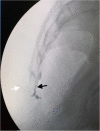Retrospective evaluation of pain in patients with coccydynia who underwent impar ganglion block
- PMID: 32393277
- PMCID: PMC7212553
- DOI: 10.1186/s12871-020-01034-6
Retrospective evaluation of pain in patients with coccydynia who underwent impar ganglion block
Abstract
Background: We aimed to evaluate pain scores one year after impar ganglion block in patients with coccydynia who did not benefit from conservative treatment.
Methods: The medical records of 29 patients with coccydynia were reviewed. Patients who were referred to the algology clinic and underwent impar ganglion blocks were retrospectively evaluated. Demographic data, time to the onset of pain, causes of pain, X-ray findings, administered invasive procedures, and visual analog scale (pain) scores were recorded.
Results: A total of 29 patients were included in the study, 10 males (34%) and 19 females (66%). The average age and body mass index were 53.45 ± 9.6 and 29.55 ± 4.21 respectively. In 21 patients, the onset of pain was associated with trauma. Nineteen patients (65.5%) had anterior coccygeal angulation. The average visual analog scale score before undergoing an impar ganglion block was 7.4 ± 1. After the procedure, the scores at < 3 months, 3-6 months and 6 months-1 year follow-up intervals were significantly lower (p < 0.05). Furthermore, visual analog scale scores at the 3-6 months and 6 months-1 year periods were significantly lower in patients who received diagnostic blocks plus pulse radiofrequency thermocoagulation than in patients who underwent a diagnostic block only.
Conclusions: The impar ganglion block provides effective analgesia without complications in patients with coccydynia. Pulse radiofrequency thermocoagulation combined with a diagnostic block prolongs the analgesic effect of the procedure.
Keywords: Chronic pain; Coccyx; Pain management; Pulsed radiofrequency treatment; Sympathetic nerve block.
Conflict of interest statement
None.
Figures
References
Publication types
MeSH terms
LinkOut - more resources
Full Text Sources
Medical


